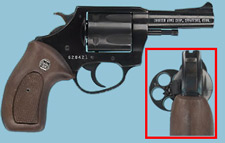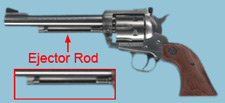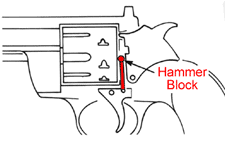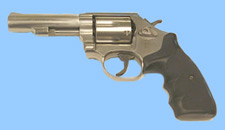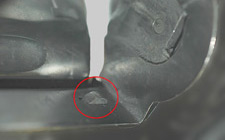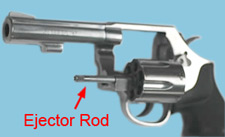Home | Glossary | Resources | Help | Contact Us | Course Map
Archival Notice
This is an archive page that is no longer being updated. It may contain outdated information and links may no longer function as originally intended.
Handguns
The term handgun refers to all firearms designed to be capable of firing with one hand. There are two general types of handguns - revolvers and pistols.
Revolvers are handguns with a cylinder containing several chambers arranged to rotate around an axis and discharge successively using the same firing mechanism. The number of chambers ranges between five and nine, typically six.
The most common revolver types are
- single action,
- double action.
Pistols are handguns with a chamber that is an integral part of the barrel. Pistols do not have rotating cylinders.
There are three types of pistol:
- Semiautomatic
- Full automatic
- Single- and multibarreled
Semi- and full automatic are by design autoloading firearms.
Single-Action Revolvers
Single-action revolvers require manual cocking of the hammer before sufficient force on the trigger releases the firing mechanism. When the hammer is pulled to the rear (cocking) an internal hand or pawl rotates the cylinder clockwise or counterclockwise, moving the next chamber into alignment with the barrel and firing pin. The hammer then locks into place along with the cylinder. Pulling the trigger releases the hammer, driving the firing pin to detonate the cartridge. Older models can be placed in a safe mode by pulling the hammer slightly to the rear; the hammer locks in place, keeping the firing pin from resting on an unfired cartridge case.
The cylinder of the single-action revolver is usually held in place by a removable pin; a loading gate is located on the right side of the firearm. By opening the loading gate and placing the hammer in an unlocked position, the cylinder can be rotated to ensure that all cylinders are empty. To the front of the chamber (located below the barrel), an ejection rod is used to eject fired cartridge cases from the cylinder. Some single-action revolvers do not have an ejection rod system and require the removal of the cylinder to remove the cartridge cases.
Modern Single-Action Revolvers
Modern single-action revolvers generally include an integrated safety feature to prevent accidental discharge. For example, Ruger revolvers use a transfer bar safety. This involves the use of a bar connected to the trigger. When the trigger is pulled, the bar is raised up to be struck by the falling hammer, transferring the energy of the hammer to the firing pin. Without the trigger being pulled, the hammer will not make contact with the firing pin.
Some single-action revolvers use a hammer block safety which, in the safe position, blocks contact between the cartridge and the hammer. When the trigger is pulled, the bar is retracted and the hammer is allowed to make contact with the firing pin, striking the cartridge.
Double-Action Revolvers
Double-action revolvers are similar to single-action revolvers, with the following exceptions:
- Function.
- Double-action revolvers allow the hammer to be cocked and released with a single pull of the trigger.
- Most double-action revolvers have the capability to function in either the double- or single-action mode. However, some models are designed to fire in the double-action mode only; the hammer cannot be manually cocked and the trigger must be pulled.
- Most double-action revolvers have the capability to function in either the double- or single-action mode. However, some models are designed to fire in the double-action mode only; the hammer cannot be manually cocked and the trigger must be pulled.
- Used in the double-action mode, the cylinder is locked into place by the cylinder stop; the hammer does not lock into place since the cocking and releasing of the hammer is achieved in one motion.
- Ejection/extraction.
- In double-action revolvers, the cylinder release device is generally located on the left rear of the frame, whereas in single-action revolvers, the loading gate is located on the right.
- By manipulating the release device, the cylinder will unlock and swing out to the left of the firearm. The front of the cylinder has an ejection rod, which is used to eject all the fired cartridge cases or cartridges from the cylinder with one movement.
Modern double-action revolvers generally use the same accidental discharge prevention mechanisms as single-action revolvers the transfer bar or the hammer block.
- Double-action revolvers allow the hammer to be cocked and released with a single pull of the trigger.
Additional Online Courses
- What Every First Responding Officer Should Know About DNA Evidence
- Collecting DNA Evidence at Property Crime Scenes
- DNA – A Prosecutor’s Practice Notebook
- Crime Scene and DNA Basics
- Laboratory Safety Programs
- DNA Amplification
- Population Genetics and Statistics
- Non-STR DNA Markers: SNPs, Y-STRs, LCN and mtDNA
- Firearms Examiner Training
- Forensic DNA Education for Law Enforcement Decisionmakers
- What Every Investigator and Evidence Technician Should Know About DNA Evidence
- Principles of Forensic DNA for Officers of the Court
- Law 101: Legal Guide for the Forensic Expert
- Laboratory Orientation and Testing of Body Fluids and Tissues
- DNA Extraction and Quantitation
- STR Data Analysis and Interpretation
- Communication Skills, Report Writing, and Courtroom Testimony
- Español for Law Enforcement
- Amplified DNA Product Separation for Forensic Analysts


